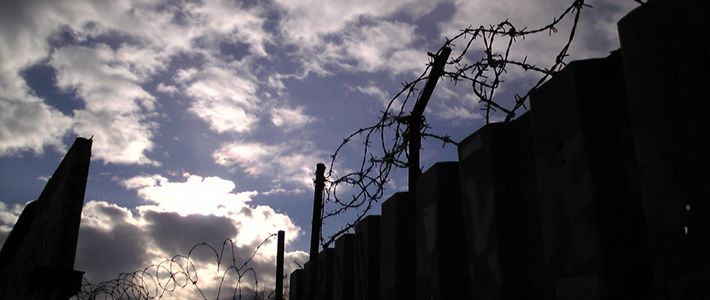
Reflections on Japan’s Post–Cold War Foreign Policy
Japan in Search of a New International Identity
Politics Society- English
- 日本語
- 简体字
- 繁體字
- Français
- Español
- العربية
- Русский
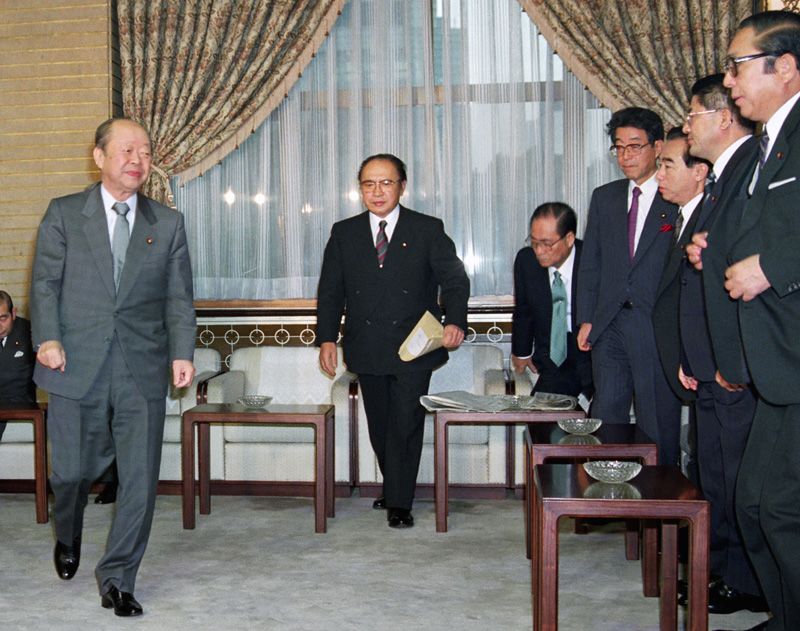
Prime Minister Miyazawa Kiichi (far left) in a cabinet meeting to iron out government recognition of the newly formed Russian Federation.
This year marks the twentieth anniversary of the collapse of the Soviet Union and the tenth anniversary of the terrorist attacks of September 11, 2001. In the United States these days, under President Barack Obama, the term “war on terror” has gone out of common use, and the main concerns for the governments of major Western countries are now economic matters, such as the debt crises in the United States and Europe. Much has changed over the past two decades, and the Cold War era has already receded into the distant past.
When the Soviet Union unraveled in 1991, Miyazawa Kiichi was Japan’s prime minister and the Liberal Democratic Party had been in control of the government for well over 30 years. But two years later the LDP fell from power for the first time since its establishment in 1955. Hosokawa Morihiro became prime minister in August 1993, heading a coalition government from which the Liberal Democrats were excluded. This marked the start of a period of great instability in domestic politics. Since then prime ministers have changed with dizzying frequency; Kan Naoto is the twelfth man to hold the post since Miyazawa was voted out in 1993. And the Japanese economy, which grew at a rapid clip through the end of the 1980s, has seen its strength erode steadily over the subsequent two decades. Over this period, during which the Japanese have been caught up largely in their domestic troubles, the global scene has shifted dramatically.
How has Japanese diplomacy responded to these international changes? In what ways has it changed, and in what ways has it stayed the same? This is the first in a series of articles in which we will present an overview of Japan’s diplomatic performance since the end of the Cold War, shining light on it from various angles. I believe we need to pause at this juncture to consider the tremendous changes that have occurred in the past 20 years and ponder the future course of Japan. This will bring into relief the country’s search for a new identity to serve as the basis for its foreign policy.

All eyes on Yoshida Shigeru, Japan’s leader immediately after World War II. The Yoshida Doctrine named after him was the policy of positioning economic growth as the nation’s top priority, while adopting a low-profile foreign policy.
No Longer the Number-Two Economy
In a speech he delivered in December 1962, Dean Acheson (US secretary of state from 1949 to 1953) referred sardonically to the lack of direction in Britain’s post–World War II foreign policy, declaring, “Great Britain has lost an empire and has not yet found a role.” Post–Cold War Japan has similarly lost its earlier international identity. One could perhaps put it like this: Japan has lost its status as an economic superpower and has not yet found a role to replace it.
In 2010, after more than 40 years as the world’s second-largest economy, Japan was overtaken by China in terms of gross domestic product. With its permanent seat on the UN Security Council, its great military might, including a nuclear arsenal, and its long history as an imperial power, China is an overwhelming presence on the Asian scene. Japan, by contrast, has relied on economic power as its means of exerting international influence, given such constraints on its security policy as its war-renouncing Constitution and sense of responsibility for past belligerence. Japan’s loss of its number-two economic ranking, a status to which most Japanese people had become accustomed, clearly signifies a decline in the country’s international clout.
So what should Japan do? After the end of the Cold War and the collapse of the bubble economy of the late 1980s, Japan entered a long tunnel of economic stagnation, and it has been questioning its own international identity. For several decades after World War II, Japan followed the so-called Yoshida Doctrine, focusing mainly on economic growth and arming itself only lightly. But this basic policy line, whose validity had been seen as self-evident since the days of Prime Minister Yoshida Shigeru (1946–47, 1948–54), came to be challenged in the mid-1990s. The economy had lost speed, and the September 1995 rape of a Japanese schoolgirl in Okinawa by US servicemen sparked a widespread debate about the Japan-US security alliance. Some people argued that Japan should lessen its dependence on the United States and pursue an Asia-oriented foreign policy. Others appealed to Japanese nationalism and called for Japan to become a great military power. It seems fair to say that Japan at this point had lost sight of its path in the post–Cold War world.
The United Nations, Asia, and the United States
A look back at Japan’s diplomacy over the decades following World War II reveals that it was actually based on a broader identity than that set forth in the Yoshida Doctrine. The Diplomatic Bluebook published by the Ministry of Foreign Affairs in September 1957 identified three principles for Japan’s foreign policy: United Nations–centered diplomacy, maintenance of Japan’s position as a member of Asia, and cooperation with the free world. These principles were partial continuations of three major currents from Japan’s prewar foreign policy, namely, internationalism, pan-Asianism, and cooperation with Britain and the United States. And they may be said to have reflected the respective positions of three major organizational units within the Foreign Ministry, namely, the International Legal Affairs Bureau, the Asian and Oceanian Affairs Bureau, and the North American Affairs Bureau. For many years during the postwar period, Japan’s diplomatic posture was largely defined by these three elements, and considerable effort was devoted to reconciling them with each other.
The three principles reflected the situation in which Japan found itself as of 1957. Japan had gained admission to the United Nations in December 1956, and the previous year had called attention to its return to the Asian community by participating in the Asian-African Conference (Bandung Conference, April 1955). Also in 1955, Foreign Minister Shigemitsu Mamoru visited the United States and started the process of renegotiating the Japan-US Security Treaty. Japan regained its sovereignty and independence in 1952, and by the mid-1950s its foreign policy was broadening to include elements other than simple cooperation with the United States. The political leaders who succeeded Yoshida after he stepped down as prime minister in 1954 worked to broaden the scope of Japan’s foreign policy, and this produced the above three principles. So to sum up, Japan’s postwar foreign policy identity was expressed in the Yoshida Doctrine and the three principles.
With the end of the Cold War, Japan faced the need to come up with new approaches to the implementation of each of the three principles. With respect to the United Nations, Japan had to involve itself more actively in issues of global security. At the time of the Gulf War in 1991, Japan provided the considerable sum of $13 billion in funds to support the coalition that freed Kuwait from Iraqi occupation, but it came under international criticism for not contributing personnel to the campaign. This response was a shock to Japanese politicians and diplomats, and it brought home to them the need for Japan to make a greater contribution in the area of international security. Based on this recognition, the Japanese government dispatched vessels from the Maritime Self-Defense Force to assist in clearing mines from the Persian Gulf after the war was over, and in the following year it sent personnel from the Self-Defense Forces to take part in the UN peacekeeping operation in Cambodia. Since then, Japan has continued to dispatch SDF personnel and others to participate in peacekeeping activities and other international security operations around the world, but its level of involvement in such endeavors is still the lowest of any major developed country. Though Japan’s dues payments and other financial contributions to the United Nations are relatively large, it lags behind in both the scale of its official development assistance (as a share of GDP) and in the number of personnel it has dispatched on peacekeeping missions; this performance belies its lofty commitment to the ideal of a UN-centered foreign policy.

Prime Minister Koizumi Jun’ichirō delivering a policy speech in Singapore.
How about Japan’s Asian diplomacy? Of the three principles, the commitment to maintaining Japan’s position as a member of the Asian community is the one whose weight has increased the most since the end of the Cold War. Japan’s Asian neighbors have achieved rapid economic growth over the past two decades, starting with the so-called Asian tigers in the early 1990s, followed by members of the Association of Southeast Asian Nations (ASEAN) and, since the start of the current century, China and India. This growth created new opportunities for the Japanese economy, and it also added to the importance of regional and bilateral foreign policy initiatives toward these countries. The first summit meeting of the Asia-Pacific Economic Cooperation forum, which was held in Seattle in 1993, attracted much attention as marking the start of an Asia-Pacific age, and the 1997 East Asian financial crisis served as the impetus for rapid development of regional cooperation through the ASEAN+3 framework, which brings the senior leaders of China, Japan, and South Korea into regular contact with their Southeast Asian counterparts. In a speech delivered in Singapore in January 2002, Prime Minister Koizumi Jun’ichirō called for the creation of a “community that acts together and advances together.” This was seen as an indication of the Japanese government’s strong desire to develop an East Asian community—a stance that played a key role in the launch of the annual East Asia Summits in 2005.
China’s rise, however, has presented Japan with a new set of diplomatic concerns. The rapid growth of the Chinese economy has been accompanied by an alarming surge in the country’s military might, leading to increased tensions in places like the East China Sea and the South China Sea, where China’s territorial claims overlap those of its neighbors. Also, the friction with China and South Korea that followed the visits by Prime Minister Koizumi to Yasukuni Shrine (which honors the spirits of Japan’s war dead) highlighted the wide gap that remains between Japan and its neighbors in the way they remember and assess their shared history. In pursuing its diplomacy toward Asia, Japan must also give consideration to these knotty issues of historical perceptions, conflicting territorial claims, and the balance of power, which have been fanning nationalistic and xenophobic sentiment in East Asian countries and interfering with regional stability. Japan’s foreign policy, while seeking to promote regional cooperation in East Asia, must also squarely confront these issues and keep working toward their solution.
Finally, what about the Japan-US alliance? How have Japan’s relations with the United States developed over the two decades since the end of the Cold War? The bilateral alliance has evolved considerably over this period. During the administration of President Bill Clinton (1993–2001), economic friction led to fears that the bilateral defense ties would weaken, and to keep this from happening, Assistant Secretary of Defense Joseph Nye promoted an initiative to redefine the alliance. Under the joint declaration issued by Clinton and Prime Minister Hashimoto Ryūtarō in 1996, the two countries reaffirmed their commitment to strengthening their bilateral alliance even in the post–Cold War era. They also set forth a policy of putting the alliance to work for the sake of broader international security as a “public good” in the Asia-Pacific region. The two countries then agreed on a new set of guidelines for their defense cooperation, and Japan confirmed its readiness to play a greater role in security affairs. In this way, the Japanese government started to pursue a more activist course with respect to security policy.
We can see, then, that over the period since the end of the Cold War, even though Japan strayed from the international identity that had previously guided its foreign policy, it did keep up its efforts to adjust to the new international realities as they related to the “three principles.”
Increased Focus on Political Matters

Prime Minister Hashimoto Ryūtarō shaking hands with Russian President Boris Yeltsin prior to the informal “no neckties” summit held in Krasnoyarsk in 1997.
Under the Yoshida Doctrine Japan’s main focus was on economic growth, and the country maintained a policy of arming itself only lightly. Following the end of the Cold War, however, Japan moved to broaden its diplomatic horizons and become more involved in international political and security matters. This can be seen, for example, in the active role it took in the Korean Peninsula Energy Development Organization, or KEDO, which was established in March 1995 to deal with the nuclear crisis that broke out the previous year on the Korean Peninsula; and in the “Eurasian diplomacy” that Prime Minister Hashimoto set forth in 1997 with a view to strengthening Japan’s ties with Russia and the countries of Central Asia. Japan’s diplomacy, which had previously centered on economic affairs, came to more consciously encompass geopolitical and strategic thinking.
Also, the Tokyo International Conference on African Development, or TICAD, a forum launched in 1993, was an important initiative showing Japan moving in advance of other countries to implement a continuous action to deal with poverty in Africa. And after the 9/11 terrorist attacks in 2001, Japan under Prime Minister Koizumi moved unhesitatingly to support the “war on terror” waged by the administration of US President George W. Bush. Japan found itself called on to become more deeply involved and cooperate more broadly with other countries in dealing with issues even in parts of the world far from its shores, such as Africa, the Middle East, and Central Asia. And it gradually stepped up its involvement in response to these calls.
This shift of emphasis from economic to political affairs and expansion of the diplomatic horizon on a global level went considerably beyond the thinking underlying the Yoshida Doctrine. This was a change produced by the Japanese government’s response to the post–Cold War global situation, and it was also in keeping with Japan’s international responsibilities as a country that had achieved one of the highest levels of economic affluence in the world. In this manner, the core of Japanese foreign policy shifted after the Cold War from economic diplomacy to an approach that included more political and security-related elements.
Values and Foreign Policy
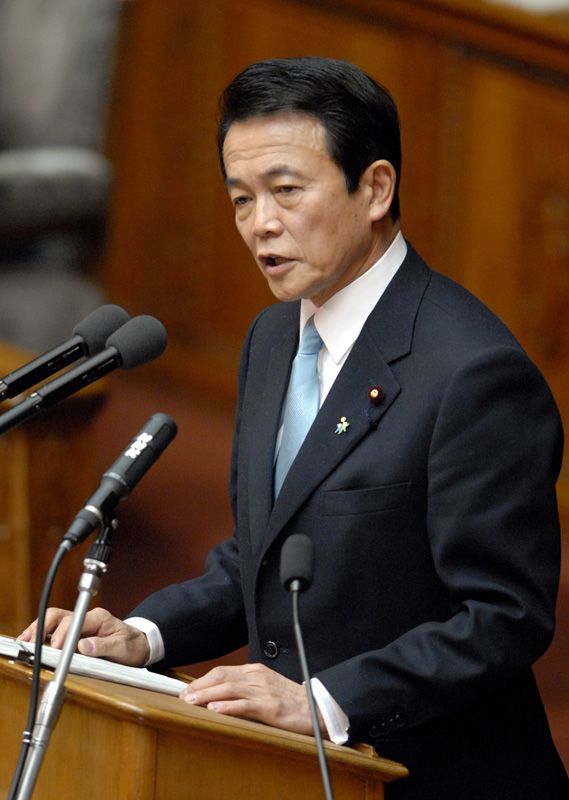
Foreign Minister Asō Tarō delivers a Diet speech on diplomatic policy.
With the start of the twenty-first century, values and ideals have come to occupy a more prominent position in international politics. The government of Britain’s Prime Minister Tony Blair, who took office in 1997, used terms like “ethical foreign policy” and “force for good,” and under the Bush administration that took power in the United States in 2001, neoconservatives advanced the cause of “regime change” to promote the spread of freedom and democracy around the world. The age of foreign policy in pursuit of purely national interests, involving raw clashes of power, was succeeded by an age in which countries spoke of their own values and worked to foster them around the world.
In response to this new current, Japan’s foreign policy also began to include references to values. For example, in a speech he delivered on November 30, 2006, Asō Tarō, serving as foreign minister under Koizumi’s successor, Abe Shinzō (prime minister from September 2006 to September 2007), referred to democracy, freedom, human rights, the rule of law, and the market economy as “universal values” and declared that Japan would emphasize these values in the conduct of its foreign policy. Asō set forth the ideas of “value-oriented diplomacy” and the “arc of freedom and prosperity” as what might be called the fourth pillar or principle of Japan’s foreign policy. In this speech he declared: “Japan is second to none in holding dear the values of freedom, democracy, and respect for human rights and the rule of law.”
Under Prime Minister Abe, Japan’s diplomatic stance thus shifted toward greater emphasis on values. But this emphasis receded under Abe’s successor, Fukuda Yasuo, who became prime minister in September 2007. The foreign policy of the Fukuda administration focused on Asia, seeking to repair the damage that Sino-Japanese relations suffered as a result of Prime Minister Koizumi’s visits to Yasukuni Shrine. This administration spoke of “synergy diplomacy” with two wheels: the Japan-US alliance and Asian diplomacy. In order to deepen ties with China, a country with a political system different from Japan’s and with which Japan does not share many values, it was necessary to downplay the idea of “values diplomacy.” Fukuda stepped down in September 2008 and was succeeded by Asō. His administration also adopted a cautious, conventional approach to foreign policy, making little reference to the “arc of freedom and prosperity” that he had spoken of while serving as foreign minister. The idea of “value-oriented diplomacy” was unable to garner broad support within the Foreign Ministry or among the politicians in the administration.
Yet Japan did move to strengthen relations with countries sharing its values of freedom and democracy, and it stressed such shared values in its existing relationships. At their June 2006 summit, Prime Minister Koizumi and President Bush issued a joint declaration titled “The Japan-U.S. Alliance of the New Century,” in which they stated, “The United States and Japan stand together not only against mutual threats but also for the advancement of core universal values such as freedom, human dignity and human rights, democracy, market economy, and rule of law,” noting, “These values are deeply rooted in the long historic traditions of both countries.” And in March 2007 Japan and Australia issued a joint declaration on security cooperation that spoke of “committing to the continuing development of their strategic partnership to reflect shared values and interests.” Australia, Japan, and the United States have been conducting “Trilateral Strategic Dialogue” meetings since 2006, working to promote three-way cooperation among Asia-Pacific countries that share the same universal values.
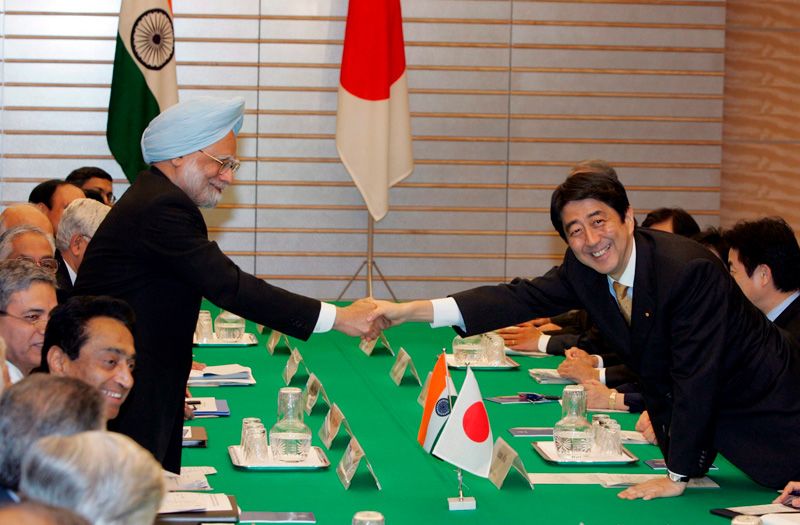
Indian Prime Minister Manmohan Singh in a meeting with Prime Minister Abe Shinzō.
In December 2010 the foreign ministers of Japan, South Korea, and the United States met in Washington DC and discussed how to respond to North Korea’s shelling of Yeonpyeong Island. In their joint statement they noted that “as three of the world's major economies with shared values, the three nations have a common cause and responsibilities to maintain stability and security in the Asia-Pacific region and globally.” In addition, Prime Minister Abe’s visit to India in August 2007 was a clear sign that these two countries, with shared values, were ready to cooperate strategically in the context of China’s rise. The joint statement by Abe and Indian Prime Minister Manmohan Singh also included a reference to the sharing of universal values like freedom and democracy. As we can see from such developments, over the past five years or so Japan has been strengthening its cooperative links with other countries in the Asia-Pacific with which it shares values. This is seen as having significance in terms of strategic balance to offset China’s military rise.
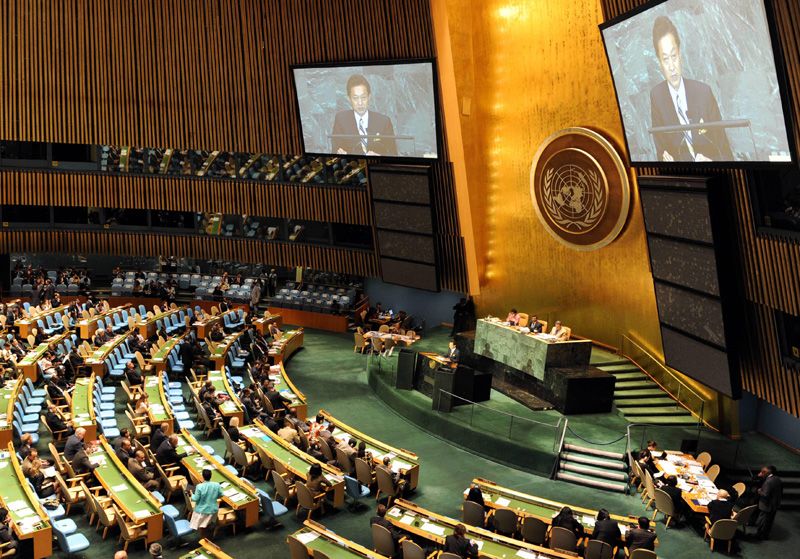
Prime Minister Hatoyama Yukio addressing the General Assembly of the United Nations in 2009. (Photo: Jiji Press)
Meanwhile, on the domestic political scene, the long-ruling Liberal Democratic Party was defeated in the August 2009 general election, and that September a new administration took power with Hatoyama Yukio, head of the Democratic Party of Japan, as prime minister. Hatoyama spoke of the concept of “fraternity” (yūai) as the core element of his policy, and he positioned the establishment of an East Asian Community as a major foreign policy plank of his administration. He declared the desire to coexist and prosper together with nations that hold values different from Japan’s, identifying friendly relations with China based on “fraternal diplomacy” as a key objective. As his model for regional integration in Asia he took the thinking of Richard Nikolaus von Coudenhove-Kalergi, said to be the father of European integration. But during his short term in office (through June 2010), Japan’s relationship with the United States suffered considerably because of the difficulties in relocating the US Marines Futenma facility in Okinawa.
Thus, over the past 10 years, Japan’s diplomacy may be said to have consisted of a mixture of two approaches: (1) efforts to build a “league of democracies” among nations sharing the same values, centering on the Japan-US alliance, and (2) a focus on regional cooperation in East Asia, centering on Sino-Japanese ties.
Whither Japan’s Foreign Policy?
In the two decades since the end of the Cold War, Japan has expanded its involvement in UN peacekeeping operations, worked to strengthen the alliance with the United States, and sought to develop regional cooperation in East Asia. These efforts have represented moves to further the three principles for Japanese diplomacy set forth in 1957. While different administrations and prime ministers have focused on different aspects, it has been clear that all three are essential.
Meanwhile, though, we continue to see considerable uncertainty among the Japanese people concerning the international identity that Japan should adopt as the basis for its foreign policy in the post–Cold War era. Japan needs to overhaul its diplomatic strategy on a comprehensive basis with respect to a number of coordinate axes, such as pacifism/international cooperation, Japan-US alliance/East Asia, and value-oriented diplomacy/economic interests. Clearly we require strong political leadership for this purpose. The frequent changes of prime minister and foreign minister have robbed Japanese foreign policy of its consistency and eroded international trust in Japan.
In this series of articles, leading experts and veterans of the policymaking process will be looking back on major events in Japanese diplomacy over the past two decades. Only by understanding these developments as a whole can we hope to find the path Japan should take and the identity it should adopt for itself on the international stage in the years to come.
(Originally written in Japanese.)
diplomacy Hosoya Yuichi United Nations Asia Japan United States Gulf War Self-Defense Forces East Asia Summit value-oriented diplomacy UN peacekeeping operations